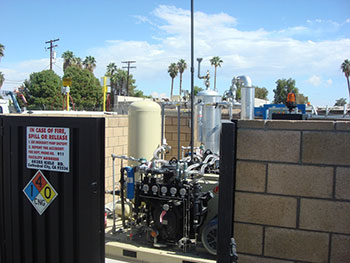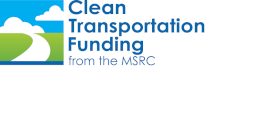
Cathedral City is committed to reducing air pollution in the city and throughout the Coachella Valley, and has been working to expand its alternative-fuel fleet over the last few years. With the help of Clean Transportation Funding from the MSRC, the city has purchased 10 CNG vehicles, built its own CNG station to support these vehicles, and looks to do more in the future.
"Cathedral City's commitment to using alternative fuels goes all the way back to the mid-90s when I first joined the City Council," said Council Member and MSRC Vice-Chair Greg Pettis. "The MSRC provided critical funding to the City to help facilitate our pledge to use cleaner fuels by offsetting the cost of the vehicles and the construction of our new CNG station. This is what the MSRC does - it helps agencies implement their plans to improve air quality for their communities, which is why I'm so proud to serve on the MSRC," said Pettis.
Deanna Pressgrove, Cathedral City's Environmental Conservation Manager agrees with Pettis about the important role the MSRC plays in projects like this. "Funding from the MSRC is extremely important," she remarked. "Without their support, the City would not be able to purchase our CNG vehicles or wouldn't have been able to build our new on-site CNG station."
Cathedral City first became the MSRC's project partner in 2001, when the MSRC awarded funding to help expand the public-access CNG station located within the city. Over the years, the MSRC has provided $225,000 to the city to purchase nine CNG heavy-duty vehicles, including six dump trucks, one water truck, a delineation truck, and a stake bed truck. The funding has also helped purchase 1 medium-duty CNG van.
The MSRC also provided more than $200,000 in funding to upgrade the city's maintenance facilities to service the CNG fleet and to help build the city's new public works CNG station, which opened in July. Since the station has only recently opened, historical data is not yet available; however, in planning the station, the city estimated that it would save thousands of dollars each year in fuel and refueling time.
In 2006, the city paid an average of $2.30 per gal equivalent for retail CNG at a local commercial station. According to the city's calculations, the city's cost to operate its new time fill CNG station will be about $1/deg (diesel equivalent gallon), including the federal energy credit of $.50/deg. Based on 240 deg/day (the estimated average fuel use for 24 CNG vehicles, which the city expected to own by the time the station was complete) for 260 days per year, the city expects to save approximately $1.30/deg, which amounts to $81,120 per year. Moreover, the city expects that it will save about $61,000 each year in staff time by having the capacity to fuel the vehicles on site, rather than traveling to a public station to fill up.
Not only has the MSRC partnered with Cathedral City for these more traditional projects, but it also helped fund an innovative project to reduce PM10 emissions from blowing sand. Blow sand is ground into fine particles by vehicles and then re-introduced into the atmosphere as particle pollution which contributes to the valley's air quality problems. In 2007, the MSRC provided approximately $79,000 to build a half-mile "living wind fence" of 315 Honey Mesquite trees along the bank of the Morongo Creek Levee to reduce blown sand deposition on three major roads. The trees were planted four to a row on a diagonal to the prevailing wind direction to intercept the sand before it crossed the creek bank. It is expected that this project will reduce PM10 emissions by .57 tons per year and more than 5 tons over its lifetime.
Since the MSRC first began its partnership with Cathedral City back in 2001, it has awarded the city with more than $670,000 in Clean Transportation Funding, and currently has one award pending. The city looks to continue to work with the MSRC in the future to build on these successful projects.
"Today, the city has 18 CNG vehicles," noted Pressgrove. "We want to expand our fleet and plan to add more, and we also work on other projects to improve our air quality, hopefully with the help and support of the MSRC," she said.
